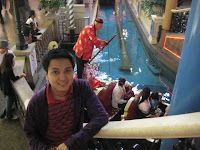
Rooms that are created by designers and artists are rarely named, unlike a work of art, or a piece of mass marketed furniture. However, one room in particular was. (And with a juicy, scandalous story behind it.) I've been waiting some years to see it, and I finally did at the Freer Gallery in Washington DC. The interior design of rooms is so fleeting, composed of everyday objects like paint, fabric, ornaments, furniture and knickknacks. They can change as quickly in color and detail as the leaves on a tree. While the initial visual impact may be memorable, its longevity is limited and subject to the whims of popular taste. Charles Lang Freer (1854-1919) recognized a masterpiece of a room and had to have it, as is. He purchased the Peacock Room in 1904. It was painstakingly taken apart and reassembled in his house in Detroit. What is so interesting about interior design is that it is much more than a space filled with furniture, color and ornamentation. It tells the story of the designer who created it, the clients who commissioned it and the people who lived in it. The Peacock Room (1876-1877) was all that.
 Sunflower andirons by Thomas Jeckyll, from around 1876. Picture from the New York Times. The room started in London with Thomas Jeckyll, a creative and innovative mid-to-late nineteenth century architect, furniture designer and metalwork designer, who has largely faded into obscurity. Mainly because many of his projects were destroyed or radically altered, in particular the dining room he designed for the London home of the wealthy shipping magnate Frederick R. Leyland.
Sunflower andirons by Thomas Jeckyll, from around 1876. Picture from the New York Times. The room started in London with Thomas Jeckyll, a creative and innovative mid-to-late nineteenth century architect, furniture designer and metalwork designer, who has largely faded into obscurity. Mainly because many of his projects were destroyed or radically altered, in particular the dining room he designed for the London home of the wealthy shipping magnate Frederick R. Leyland.  Arrangement in Black: Portrait of F.R. Leyland by James McNeill Whistler, (1870-1873). In the Freer Gallery. Leyland wanted his valuable collection of Chinese porcelains to be showcased in his dining room. His collection consisted of Qing-dynasty pieces, primarily from the Kangxi period (1662-1722), in an assortment of shapes and sizes. Jeckyll constructed an étagère of sorts – with beautifully intricate carved shelving with varying heights to frame each piece of porcelain. He then tacked up antique leather on the walls. Supposedly, leather salvaged from the wreck of the Spanish Armada in 1588, which an antique dealer who sold it to him had claimed. Jeckyll painted a few pomegranates and flowers on it but left the natural rich, dark color. A painting by James McNeill Whistler (1834-1903) called La Princesse du pays de la porcelaine (The Princess from the Land of Porcelain) was placed above the fireplace, (see top photo). Leyland commissioned quite a few works from Whistler and they soon became friends.
Arrangement in Black: Portrait of F.R. Leyland by James McNeill Whistler, (1870-1873). In the Freer Gallery. Leyland wanted his valuable collection of Chinese porcelains to be showcased in his dining room. His collection consisted of Qing-dynasty pieces, primarily from the Kangxi period (1662-1722), in an assortment of shapes and sizes. Jeckyll constructed an étagère of sorts – with beautifully intricate carved shelving with varying heights to frame each piece of porcelain. He then tacked up antique leather on the walls. Supposedly, leather salvaged from the wreck of the Spanish Armada in 1588, which an antique dealer who sold it to him had claimed. Jeckyll painted a few pomegranates and flowers on it but left the natural rich, dark color. A painting by James McNeill Whistler (1834-1903) called La Princesse du pays de la porcelaine (The Princess from the Land of Porcelain) was placed above the fireplace, (see top photo). Leyland commissioned quite a few works from Whistler and they soon became friends.  Whistler, Self-Portrait, (1872). Once Whistler's Painting of the Princess was framed and neatly affixed to the wall, and Leyland's prized collection of blue and white porcelain was each carefully put into place, the doors leading into the dining room still needed to be done. Jeckyll asked Whistler, who was working on decorations for the entrance hall of the house, for his advice. Whistler scratched his head, sighed and said he was unhappy with the muted paint of the flowers on the wall and wished to paint over it in yellow and gold to bring out the color of his painting. Leyland, a very busy man, agreed. Whistler still wasn't happy and Leyland gave him permission to paint a wave pattern above the wainscoting. Believing the room was almost finished; Leyland went back to his business in Liverpool.
Whistler, Self-Portrait, (1872). Once Whistler's Painting of the Princess was framed and neatly affixed to the wall, and Leyland's prized collection of blue and white porcelain was each carefully put into place, the doors leading into the dining room still needed to be done. Jeckyll asked Whistler, who was working on decorations for the entrance hall of the house, for his advice. Whistler scratched his head, sighed and said he was unhappy with the muted paint of the flowers on the wall and wished to paint over it in yellow and gold to bring out the color of his painting. Leyland, a very busy man, agreed. Whistler still wasn't happy and Leyland gave him permission to paint a wave pattern above the wainscoting. Believing the room was almost finished; Leyland went back to his business in Liverpool.  But Whistler changed a lot more.
But Whistler changed a lot more.  He covered the ceiling with gold leaf, and on top of that he painted a pattern of peacock feathers. He also gilded Jeckyll’s walnut shelving. Jeckyll was long gone from the house at this point. Whistler knew exactly what to do about Jeckyll’s door quandary – he painted four fantastically plumed peacocks against a shining gold ground, two on each set of doors.
He covered the ceiling with gold leaf, and on top of that he painted a pattern of peacock feathers. He also gilded Jeckyll’s walnut shelving. Jeckyll was long gone from the house at this point. Whistler knew exactly what to do about Jeckyll’s door quandary – he painted four fantastically plumed peacocks against a shining gold ground, two on each set of doors.  Whistler was thrilled with himself and wrote to Leyland that his dining room was "really alive with beauty — brilliant and gorgeous while at the same time delicate and refined to the last degree." He urged Leyland not to hurry his return to London as was not entirely finished with the room and did not want to spoil the surprise. In the meantime, once he had completed the room Whistler invited friends over to view it, printed up a pamphlet and distributed it all over London for people to come see it. He even held press conferences in the room. Apparently Mrs. Leyland, who remained in the house, didn’t mind. Was she a bit smitten by the arrogant, bad boy artist?
Whistler was thrilled with himself and wrote to Leyland that his dining room was "really alive with beauty — brilliant and gorgeous while at the same time delicate and refined to the last degree." He urged Leyland not to hurry his return to London as was not entirely finished with the room and did not want to spoil the surprise. In the meantime, once he had completed the room Whistler invited friends over to view it, printed up a pamphlet and distributed it all over London for people to come see it. He even held press conferences in the room. Apparently Mrs. Leyland, who remained in the house, didn’t mind. Was she a bit smitten by the arrogant, bad boy artist?  Leyland returns and does not find it "alive with beauty". He becomes irate. Whistler smugly sends him a bill twice of what the original antique red leather walls procured by Jeckyll cost. Leyland pays Whistler, but only half the amount. This does not sit well with the artist.
Leyland returns and does not find it "alive with beauty". He becomes irate. Whistler smugly sends him a bill twice of what the original antique red leather walls procured by Jeckyll cost. Leyland pays Whistler, but only half the amount. This does not sit well with the artist.  Leyland leaves the house again and Whistler somehow gains entrance once more. (Perhaps because he was on friendly terms with Leyland’s wife?) Whistler felt the leather walls would look better in Prussian blue and began to coat all the leather walls with paint. On the opposing wall from the Princess painting, Whistler depicted two more peacocks fighting each other -- one with money under his claw and silver feathers on his throat which signified the ruffled shirts Leyland always wore. The other peacock squawking in defiance with a silver crest feather that resembles the lock of white hair which curled above Whistler's forehead.
Leyland leaves the house again and Whistler somehow gains entrance once more. (Perhaps because he was on friendly terms with Leyland’s wife?) Whistler felt the leather walls would look better in Prussian blue and began to coat all the leather walls with paint. On the opposing wall from the Princess painting, Whistler depicted two more peacocks fighting each other -- one with money under his claw and silver feathers on his throat which signified the ruffled shirts Leyland always wore. The other peacock squawking in defiance with a silver crest feather that resembles the lock of white hair which curled above Whistler's forehead. 
Leyland banned Whistler from the house and Whistler was never to see the room again. But he continues his alleged affair with Mrs. Leyland.
The Leylands separated shortly afterwards. Despite all the controversy, Leyland kept his dining room as is and continued filling the shelves with porcelain until his death.
The redecoration of Jeckyll's room generated lasting praise for Whistler and completely overshadowed Jeckyll's considerable role in the creation of dining room.
When Jeckyll saw what Whistler had done, he fled from the house and was reported to be found babbling while frantically working gilding his own floor at home in his bedroom. He died soon afterwards in an asylum. Whistler was reported to have said: "That's the effect I have on people".
 Symphony in Flesh Colour and Pink: Portrait of Mrs Frances Leyland (1872-1873) at the Frick. Although there are no hard facts that Whistler and Frances Leyland had a roll in the hay, it is interesting to note that Whistler has given more time an attention to the great detail on Mrs. Leyland's dress (which he chose for her to wear) rather than the details of her face...
Symphony in Flesh Colour and Pink: Portrait of Mrs Frances Leyland (1872-1873) at the Frick. Although there are no hard facts that Whistler and Frances Leyland had a roll in the hay, it is interesting to note that Whistler has given more time an attention to the great detail on Mrs. Leyland's dress (which he chose for her to wear) rather than the details of her face... 























































